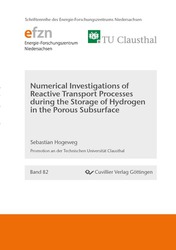| Fachbereiche | |
|---|---|
| Buchreihen (96) |
1378
|
| Nachhaltigkeit |
3
|
| Gesundheitswesen |
1
|
| Geisteswissenschaften |
2365
|
| Naturwissenschaften |
5406
|
| Ingenieurwissenschaften |
1793
|
| Allgemeine Ingenieurwissenschaften | 292 |
| Maschinenbau und Verfahrenstechnik | 862 |
| Elektrotechnik | 686 |
| Bergbau- und Hüttenwesen | 30 |
| Architektur und Bauwesen | 75 |
| Allgemein |
98
|
|
Leitlinien Unfallchirurgie
5. Auflage bestellen |
|
Erweiterte Suche
Numerical Investigations of Reactive Transport Processes during the Storage of Hydrogen in the Porous Subsurface (Band 82)
Sebastian Hogeweg (Autor)Vorschau
Leseprobe, PDF (8,5 MB)
Inhaltsverzeichnis, PDF (47 KB)
This thesis investigates Underground Hydrogen Storage (UHS) in the porous subsurface by numerical simulation. Particular focus is placed on hydrodynamics and potential bio- and geochemical reactions caused by interactions of hydrogen, microorganisms, and rock minerals, respectively. For this purpose, a mathematical model for the bio-geo-reactive transport in porous media was developed and incorporated in the open-source simulator DuMux.
The implementation was calibrated by the reproduction of recent laboratory experiments regarding molecular diffusion and bio- and geochemical reactions. Initial field-scale simulation runs were performed to estimate the risk of temporal and permanent hydrogen losses during UHS operation. Subsequently, the model was extended for the implementation of mechanical dispersion, strengthening the gas-gas mixing, and subsequently, predictions for an ongoing field test in Germany were made. In the last step, the realization in DuMux was used to predict the potential stimulation of methanogenic microorganisms to initiate the concept of Underground Bio Methanation.
| ISBN-13 (Printausgabe) | 9783689520014 |
| ISBN-13 (E-Book) | 9783689520434 |
| Buchendformat | A5 |
| Sprache | Englisch |
| Seitenanzahl | 198 |
| Umschlagkaschierung | matt |
| Auflage | 1. |
| Buchreihe | Schriftenreihe des Energie-Forschungszentrums Niedersachsen (EFZN) |
| Band | 82 |
| Erscheinungsort | Göttingen |
| Promotionsort | TU Clausthal |
| Erscheinungsdatum | 05.07.2024 |
| Allgemeine Einordnung | Dissertation |
| Fachbereiche |
Ingenieurwissenschaften
Energietechnik |
| Schlagwörter | Underground Hydrogen Storage, Underground Bio Methanation, Underground Energy Storage, Numerical Reservoir Simulation, Open-Source Simulator, Bio-Geo-Reactive Transport, Porous Media, Molecular Diffusion, Mechanical Dispersion, Geochemistry, Microbiology, Unterirdische Wasserstoffspeicherung, unterirdische Biomethanisierung, unterirdische Energiespeicherung, numerische Reservoirsimulation, Open-Source-Simulator, bio-georeaktiver Transport, poröse Medien, molekulare Diffusion, mechanische Dispersion, Geochemie, Mikrobiologie, DuMux |








